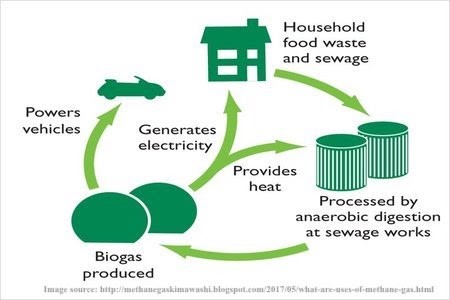Description

Disclaimer: No Copyright infringement intended.
In News
- A new high rate biomethanation technology for the integrated treatment of sewage and organic solid waste and concomitant generation of biogas and bio manure can treat groundwater and wastewater and convert it to potable water. It can be used for sewage and organic solid waste treatment with decentralized applications in various parts of India.
- Solid and liquid wastes are major challenges faced by big cities as also for the rapidly urbanizing areas, and sustainable technologies are needed for tackling them.
- An integrated treatment of sewage along with organic solid waste in India could help evolve a sustainable technology to overcome the solid and liquid waste disposal issues.
About
- Biomethanation is a process by which organic material is microbiologically converted under anaerobic conditions to biogas.
- Three main physiological groups of microorganisms are involved: fermenting bacteria, organic acid oxidizing bacteria, and methanogenic archaea.

Biogas
- Biogas mainly consists of methane (about 60-75%), carbon dioxide (about 25-40%) besides small quantities of NH3 and H2S and has a Calorific Value of about 5000 kcal /m3.
- Depending upon the waste composition, the biogas production ranges from 50-150m3/tonne of wastes.
- The biogas can be utilised either for cooking / heating applications, or for generating motive power or electricity through dual-fuel, gas engines, low pressure gas turbines or steam turbines.
- The sludge from anaerobic digestion, after stabilisation, can be used as a soil conditioner, or as manure depending upon its composition, which is determined mainly by the composition of the input waste.
Advantages of Anaerobic Digestion / Biomethanation
- Generation of gaseous fuel;
- Can be done on a small-scale;
- No external power requirement unlike aerobic treatment;
- Enclosed system enables all the gas produced to be collected for use. Green house gases
- Emission to the atmosphere is avoided;
- Free from bad odour, rodent and fly menace, visible pollution and social resistance;
- Modular construction of plant and closed treatment needs less land area; and
- Production of biogas and high grade soil conditioner.
Disadvantages
- In case of digesters operated under mesophilic temperatures, destruction of pathogenic organisms may be less than that in Aerobic Composting. However, several digester systems operated at high thermophilic temperatures are also available;
- It is more capital intensive compared to composting and landfill; and
- Not suitable for wastes containing less biodegradable matter.
Limitations/ Constraints
- The growth of this sector has been affected on account of the following limitations/ constraints:
- Waste-to-Energy is still a new concept in the country;
- Most of the proven and commercial technologies in respect of urban wastes are required to be imported;
- The costs of the projects especially based on biomethanation technology are high as critical equipment for a project is required to be imported.
- In view of low level of compliance of MSW Rules 2000 by the Municipal Corporations/ Urban Local Bodies, segregated municipal solid waste is generally not available at the plant site, which may lead to non-availability of waste-to-energy plants.
- Lack of financial resources with Municipal Corporations/Urban Local Bodies.
- Lack of conducive Policy Guidelines from State Govts. in respect of allotment of land, supply of garbage and power purchase / evacuation facilities.
Final Thoughts
- The underdeveloped state of waste management in India is a motivation for the study of eco-friendly processes like biomethanation and bioremediation.
- The installation of biogas plants across various research institutes in India, like Sardar Patel Renewable Energy Research Institute (SPRERI) in Gujrat, Biogas Plant at Trombay, Appropriate Rural Technology Institute (ARTI) in Pune and Bhabha Atomic Research Centre (BARC) in Mumbai, practice biomethanation in a full-fledged process and yield high rate of biogas fuel from waste materials.
- The biogas produced is clean, economical and used for commercial purposes.
- But the government needs to invest more on this technology so that it percolates down to local bodies.
https://pib.gov.in/PressReleasePage.aspx?PRID=1751723
















